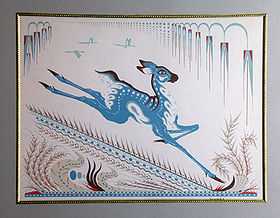Bacone school

The Bacone style or Bacone school of painting, drawing, and printmaking is a Native American Flatstyle art movement, primarily from the mid-20th century in Oklahoma. This art movement bridges traditional tribally-specific pictorial painting and carving traditions towards an intertribal Modernist style of easel painting.
Origin
Named for Bacone College, an Indian college in Muskogee, Oklahoma, this style is also influenced by the art programs of Chilocco Indian School, north of Ponca City, Oklahoma, and Haskell Indian Industrial Training Institute, in Lawrence, Kansas. This area features a mix of Southeastern, Prairie, and Central Plains tribes. Tribes from these regions each have their own traditions of pictorial representation, whether in carving or painting; however, removal to Indian Territory in the 19th century disrupted many traditional art practices. Access to Western art materials gave Native artists a new means of self-expression and history recording.
Acee Blue Eagle (1907-1959) helped shape the Bacone style. Being Muscogee Creek, Pawnee, and Wichita, he used Southeastern Woodland and Central Plains influences in his work, which frequently portrayed cultural or historic information about his tribes in a stylized, narrative form. Blue Eagle served as director of Bacone's art department from 1935-1939.[1] Woody Crumbo succeeded him in 1938.[2] 1938 is the year artist Ruthe Blalock Jones gives for the establishment of the Bacone School of Indian painting,[3] while some would give the year 1935.[4]
The Bacone style differs from the two other prevalent flat styles of Native painting of the time: Southern Plains style and the Studio style. The Southern Plains style had its origins in traditional hide painting and Winter counts. After the decline of buffalo herds in the late 19th century, Plains painting evolved into Ledger art, which, under the stewardship of such artists as Silver Horn (1860/1-1940, Kiowa), evolved into easel art, and gained international fame with the Kiowa Five. The Southern Plains style is the most dynamic, action-based of these mid-20th-century painting styles.
The Studio style, as taught at the Santa Fe Indian School, built upon the accomplishments of the San Ildefonso Pueblo school of painters and Hopi painters such as Fred Kabotie, who were successful easel artists in the 1910s and 1920s in Arizona and New Mexico. These artists drew upon Pueblo mural painting and pottery painting traditions. Their work often features pastoral scenes in muted colors.[4] Collectively, these three Flatstyle movements were sometimes derided by Native artists in the 1960s as "Bambi Art"–criticized as nostalgic, sentimental, and limited in scope.[5]
Style and media
Both Blue Eagle's and Crumbo's styles were also influenced by the streamlined, bold look of Art Deco.[4] Casein on illustration board was a popular medium, as well as gouache and watercolor. Technical skill in draftsmanship was emphasized, as was ethnographic accuracy of subjects portrayed. Paintings were aesthetically pleasing, with contours of a certain hue often surrounded by outlines of lighter tints, to emphasize the spiritual nature of the subject. Figures were brilliantly colored with backgrounds of a "subdued palettes of greens, blues, and browns," as Ruthe Blalock Jones writes.[6] Blue in particular is a color representing sorrow, loss, and memory for some Southeastern tribes, and is often a preferred background color. Implied narrative gave the Bacone style a sense of drama.[4]
Development
The Philbrook Museum of Art of Tulsa, Oklahoma helped foster the development of the Bacone style with its Indian Annual competitive art show from 1947 to 1957.[7] The Five Civilized Tribes Museum of Muskogee, Oklahoma and the Cherokee Heritage Center of Park Hill, Oklahoma both have annual arts shows with categories specifically for this style of art (the Cecil Dick award and the Jerome Tiger award, respectively). The Gilcrease Museum in Tulsa, Oklahoma and National Cowboy and Western Heritage Museum in Oklahoma City have extensive collections of Bacone School art.
Notable Bacone School artists
- Archie Blackowl, Southern Cheyenne
- Fred Beaver, Muscogee Creek-Seminole[8]
- Acee Blue Eagle, Muscogee Creek-Pawnee-Wichita
- Woody Crumbo, Potawatomi[9]
- John Gritts, Cherokee
- Franklin Gritts, Cherokee
- Albert Harjo, Muscogee Creek
- Joan Hill, Muscogee Creek-Cherokee[10]
- Ruthe Blalock Jones, Shawnee-Delaware-Peoria
- Barbara McAlister, Cherokee Nation
- Solomon McCombs, Muscogee Creek[5]
- Jackson Narcomey, Muscogee Creek
- Terry Saul, Choctaw Nation of Oklahoma
- Jerome Tiger, Muscogee Creek-Seminole[11]
- Dick West, Southern Cheyenne
See also
- Native American art
- List of Native American artists from Oklahoma
Notes
- ↑ Silberman 47
- ↑ Silberman, 86
- ↑ Wyckoff, 55
- ↑ 4.0 4.1 4.2 4.3 Parker, Gerri. "Native American Art in Oklahoma: The Kiowa and Bacone Artists." DeAnza College. 27 July 2004 (retrieved 8 Nov 2009)
- ↑ 5.0 5.1 Morand et al, 105
- ↑ Wyckoff, 54
- ↑ Wyckoff, 40
- ↑ Silberman, 52
- ↑ Morand et al, 110
- ↑ Silberman, 106
- ↑ Morand et al, 111
References
- Morand, Anne, Kevin Smith, Daniel C. Swan, and Sarah Erwin. Treasures of Gilcrease: Selections from the Permanent Collection. Tulsa, OK: Gilcrease Museum, 2003. ISBN 978-0-8061-9955-9.
- Silberman, Arthur. 100 Years Native American Painting. Oklahoma City: The Oklahoma Museum of Art, 1978.
- Wyckoff, Lydia L., ed. Visions and Voices: Native American Painting from the Philbrook Museum of Art. Tulsa, OK: Philbrook Museum of Art, 1996. ISBN 0-86659-013-7.